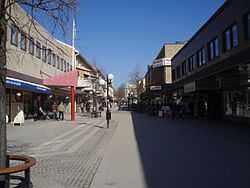Köping, Sweden
| Köping | |
|---|---|
 | |
 Köping | |
| Coordinates: 59°31′N 15°59′E / 59.517°N 15.983°ECoordinates: 59°31′N 15°59′E / 59.517°N 15.983°E | |
| Country | Sweden |
| Province | Västmanland |
| County | Västmanland County |
| Municipality | Köping Municipality |
| Charter | January 19, 1474 |
| Area[1] | |
| • Total | 11.86 km2 (4.58 sq mi) |
| Population (31 December 2010)[1] | |
| • Total | 17,743 |
| • Density | 1,496/km2 (3,870/sq mi) |
| Time zone | CET (UTC+1) |
| • Summer (DST) | CEST (UTC+2) |
Köping is a locality and the seat of Köping Municipality in Västmanland County, Sweden. It had 17,743 inhabitants in 2010.[1] It is known for the television series I en annan del av Köping.
History

Köping means merchant place. It was mentioned for the first time in the 13th century. It probably was referred to such a name as it did not yet have a charter. The central location of Köping deems it appropriate for merchancy for people from different parts of the country.
Köping, with central and southern Sweden was Christianised in the 11th century. A church built around the year 1300, the Köping Church, still remains from the early days.
Köping got its charter on January 19, 1474.
In the 17th century Köping municipality produced large amounts of iron that was transported to other countries.
In the 19th century Köping established itself as an industrial city, with a large mechanical workshop and a prosperous harbor. A fire in 1889 destroyed large parts of Köping, whereafter it was rebuilt using stone material under supervision of architect Theodor Dahl.
In the 20th century all kinds of companies have established themselves in Köping. Volvo built a large industry there in the 1920s; the arguably most known bed manufacturer in Sweden, Hästens, in 1924; and a number of gold groceries between 1940-1960.
Gallery
-

The Town Hall in Köping
-
Köping church
-

Köping railway station
Sports
The following sports clubs are located in Köping:
Notable natives
- Carl Wilhelm Scheele - 18th century Chemist who discovered the functions of oxygen
- Richard Dybeck - One of the writers of the Swedish national anthem
- Henrik Sjögren - Ophthalmologist best known for the eponymous condition Sjögren's syndrome
- Emir Bajrami - Plays in the Swedish national football team.
- Charta 77 (band) - Swedish Punkrock band
References
- ↑ 1.0 1.1 1.2 "Tätorternas landareal, folkmängd och invånare per km2 2005 och 2010" (in Swedish). Statistics Sweden. 14 December 2011. Archived from the original on 10 January 2012. Retrieved 10 January 2012.
| |||||
| ||||||||||||||
